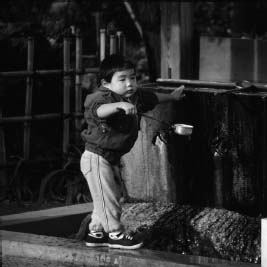ShintoCustoms and Rituals |
What place does purification occupy in Shinto ritual? |
Few traditions place greater emphasis on the need to purify both participants in ceremonies and the place designated for the rites. Just as the primordial deity, Izanagi, purified himself upon exiting from the underworld, so must all worshippers cleanse before engaging in sacred rituals. The contrasting states of pollution or spiritual alienation (kegare) and ritual-moral purity (harae) encompass a great deal of what Shinto tradition considers important. Purification with water is a prerequisite to even the simplest acts of worship. As an ordinary part of rituals performed by priests and shrine staff, purification requires waving a wand over the individuals or their offerings, and sometimes involves sprinkling saltwater or salt. Watch a Sumo wrestling match and you will see the behemoth contestants liberally scattering fistfuls of salt across the ring as they enter to confront each other—a clue to the ancient religious associations of the sport.
More elaborate purification involves ceremonial bathing to cleanse the individual of pollution and sin. Priests sometimes purify by immersion before major rites. Some adepts seek out sacred mountain waterfalls and stand beneath their frigid cataracts in winter as an especially potent form of purification. Most important is the ceremony called “great purification,” in which priests of the imperial household, and those throughout the country, symbolically purify the whole nation—the whole world, according to some interpretations. Reciting prayers, they mark the middle and end of the year with cleansing. Before a major festival, shrine priests put considerable time and effort into preparing themselves and the site. Officiants enter seclusion the day before the festival, bathe several times, and follow strict rules with respect to clothing, food, and abstinence from sexual activity.

Japanese boy prepares to offer the author a ladle of water for purification at a small Shinto shrine in Tokyo.
